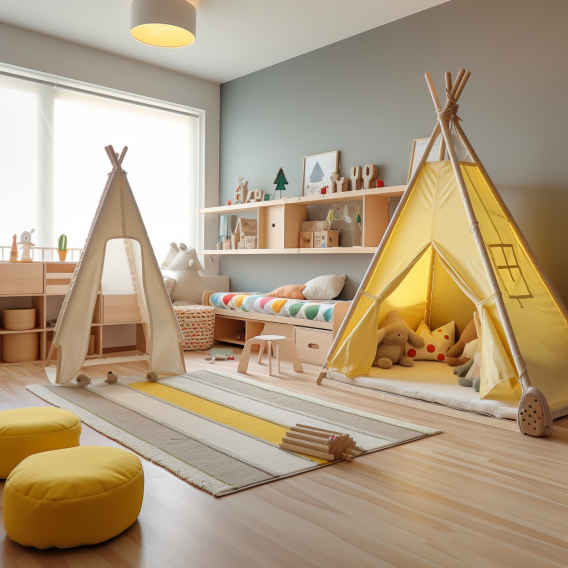Montessori education principles prioritize independence, exploration, and a child’s natural development. When applied to designing a child’s bedroom, these principles can create a nurturing and enriching environment. Here are ways to incorporate Montessori principles into your child’s room design:
- Low Furniture: Montessori rooms often feature low furniture, including beds and shelves, allowing children to access items independently.
- Child-Centered Layout: Arrange furniture and items to encourage movement and exploration. Place items where your child can reach them easily.
- Natural Materials: Choose furniture and decor made from natural materials like wood and cotton. These materials are safe, eco-friendly, and promote sensory experiences.
- Neutral Colors: Opt for a calming color palette with neutral hues. Soft colors create a serene atmosphere conducive to concentration and relaxation.
- Open Shelving: Use open shelves at child height to display toys and books, making it easy for your child to choose activities independently.
- Accessible Toys: Store toys in baskets and open containers that allow children to see and choose their playthings easily.
- Child-Sized Furniture: Include child-sized tables and chairs for play, art, and other activities. These encourage independence and autonomy.
- Minimalistic Decor: Keep decor simple and uncluttered. Montessori environments promote focus and concentration, which can be disrupted by too much visual stimulation.
- Practical Life Activities: Create areas for practical life activities, such as dressing, hygiene, and food preparation. Child-sized sinks and low clothing racks can encourage independence.
- Art and Creativity Stations: Dedicate a space for art and creative expression. Provide art supplies and display your child’s artwork prominently.
- Low Beds: Montessori-style floor beds allow children to get in and out independently. Add a soft rug nearby for comfort.
- Child-Friendly Mirrors: Hang mirrors at your child’s eye level, encouraging self-recognition and exploration.
- Nature-Inspired Decor: Bring elements of nature into the room, like potted plants, nature-themed artwork, and natural light.
- Access to Nature: If possible, design the room to have easy access to outdoor spaces, fostering a connection with nature.
- Personalization: Involve your child in decorating their space. Let them choose decor items and contribute to the design.
- Safety First: Ensure the room is childproofed, and all furniture and materials are safe and age-appropriate.
- Order and Routine: Establish routines for activities like dressing, naptime, and play. A consistent environment supports independence.
- Child-Safe Materials: Use non-toxic, child-safe materials for paints, furnishings, and toys.
- Child-Accessible Storage: Provide low, open storage for clothing and personal items, allowing children to learn self-care skills.
- Reading Nook: Create a cozy reading nook with a variety of books at your child’s level.
- Respect the Child’s Pace: Allow your child to explore and learn at their own pace. Encourage independence but respect their need for assistance when required.
Incorporating Montessori principles into your child’s room design fosters independence, creativity, and a sense of ownership over their space. It promotes a nurturing environment where your child can thrive, learn, and develop essential life skills.


